ABSTRACT
The wild dioecious plant Corema album, endemic to the Atlantic coast of the Iberian Peninsula, has potential to become a new crop and to integrate the berry fruit market. Due to its potential, the aim of this study was to propose a BBCH (Biologische Bundesanstalt, Bundessortenamt and CHemical Industry) scale for the species. Based on field observation, the principal growth stages were described and sequentially established. Photographs and stereomicroscope acquisition software were used to illustrate the phenological stages of male and female plants.
The scale includes seven principal stages starting with bud development (stage 0), followed by leaf development (Stage 1), main stem elongation (Stage 3), inflorescence emergence (Stage 5), flowering (Stage 6), fruit development (Stage 7) and ending with fruit maturation (stage 8), with mesostages for male and female inflorescence (stage 5) and flower development (stage 6). Through field observations carried out in plants in different growth conditions, the proposition of this extended BBCH scale was made, to have a standardized system for Corema album phenological stages. This study will have an application especially in fields of agronomy and plant breeding and will also be a stepping stone for the inclusion of this species as a novelty crop in a nearby future.
KEYWORDS:
Introduction
Corema album (L.) D. Don, known as white crowberry, is an endemic evergreen dioecious species from the Iberian Peninsula with the potential to integrate the small fruits market, due to the unique white colored berries (Oliveira and Dale, Citation2012). The white crowberry, from the family Ericaceae, is one of two species found in the Corema genus. Corema album is divided into two subspecies, C. album spp. azoricum P. Silva found in six of the nine Azores Islands and C.album spp. album found in the Atlantic coast of Portugal and Spain. In the work published by Lopéz-Dóriga (Citation2018), it was referred that new populations were described in the Spanish Province of Alicante and in France, the latter by introduction and naturalization. The work also proposed a potential extent of occurrence of this species, based on the current distribution, since a small population was found located in the province of Valencia in Spain, and also the French population. The white crowberry can reach a height of one m, but the average height stays between 30 and 75 cm. This shrub has many branches, where the leaves occur in whorls of three or four, with short petioles (Franco, Citation1984; Tutin et al., Citation1972). Flowers appear in terminal inflorescences, in groups of 4–14 flowers, but never more than 20 and their number depending on sex (Álvarez-Cansino et al., Citation2010; Guitián et al., Citation1997). The fruits are small drupes that develop in the middle of the branch as the terminal bud continues to grow. The berries have a diameter that range from 5 to 8 mm and have usually three seeds, called pyrenes, with variable sizes not proportional to fruit size (Simmonds, Citation1979; Tutin et al., Citation1972).
Its edible berries have been traditionally consumed in coastal areas. They have been sold as fresh fruits, made into jams and liquors or even as traditional medicine (Font-Quer, Citation1993; Gil-López, Citation2011; González, Citation2006). Studies in the biochemical composition confirm that fruit extracts contain high amounts of antioxidants and phenolic acids (Andrade et al., Citation2017b; León-González et al., Citation2013). Fruits are also considered a source of water, fibers and sugars (Andrade et al., Citation2017a).
BBCH scale has been used in many crops (Meier, Citation1997), such as cereals, colza, bean (Lancashire et al., Citation1991), potato (Hack et al., Citation1993) and Proso millet (Ventura et al., Citation2020). Fruit trees, like pome and stone fruit (Meier et al., Citation1994), grapevine (Lorenz et al., Citation1994), citrus (Agustí et al., Citation1997), olive (Sanz‐Cortés et al., Citation2002), kiwifruit (Salinero et al., Citation2009), cape gooseberry (Ramírez et al., Citation2013), feijoa (Ramírez and Kallarackal, Citation2018), cashew tree (Adiga et al., Citation2019), mangosteen (Awachare and Upreti, Citation2020), lulo (Ramírez and Davenport, Citation2020) and persimmon (Guan et al., Citation2021) have also been described in detail according to the BBCH scale.
BBCH scale could either be a primary or an extended scale. The primary BBCH scale takes into account primary and secondary stages (two digit scale), describing plant development. Extended BBCH scale uses three digit codes, to describe more detailed phenological stages, and mesostages are incorporated between the principal and secondary stages (Hack et al., Citation1992). Mesostages can be used to describe the development of similar structures (e.g. main stem and side shoots) (Meier, Citation1997).
Previous Corema album’s studies, all of them along the Atlantic Coast of Portugal and Spain, have already characterized the species phenology, especially regarding the reproductive phase, emphasizing the efforts of developing reproductive vs vegetative organs (Álvarez-Cansino et al., Citation2010; Díaz-Barradas et al., Citation2018; Guitián et al., Citation1997; Oliveira and Dale, Citation2012; Zunzunegui et al., Citation2006). A first approach to a BBCH scale for C. album has already been done (Magalhães, Citation2015; Magalhães et al., Citation2017); however, in the present investigation, attempts have been made to fill some of the gaps. The full cycle on the plant phenological development was accessed. More precise descriptions were made in this study, as well as more accurate timings for the phenological stages.
Corema album show differences regarding the vegetative and reproductive development timings. Female plants develop vegetative organs earlier (February to April); however, during fruit setting (May to June/July) male plants have bigger vegetative growths (Zunzunegui et al., Citation2006). The number of reproductive organs differs from gender, with male plants having a higher number of inflorescences and flowers, with an average of nine flowers/inflorescence, whereas female plants have seven flowers/inflorescence (Guitián et al., Citation1997).
The aim of this work is to describe Corema album’s phenological growth stages according to the extended BBCH scale, to develop an important tool to support research studies on this emerging berry crop.
Materials and Methods
Plant Material and Environmental Conditions
Phenological stages of Corema album and respective codes were based on long-term observations. First, in wild conditions (), we followed two male and two female C. album plants from Praia do Meco (38°29ʹ23.7”N 9°10ʹ53.5”W), Portugal. This location is a coastal dune system, with sandy soils, near Atlantic Ocean. This is a Mediterranean pluviseasonal site, with a Lang’s thermopluviometric index of 40.5, being considered a wet climate (Álvarez-Cansino et al., Citation2012). Weather data from an historical data set from 1971 to 2000 was used from Setubal district, where Praia do Meco is located (period 1971–2000; IPMA, Citation2018). The soils have at least 70% sand and at the most 30% clay. Organic matter varies between 0 and 2.6%, and pH can vary from 5.6 to 7.8 (Hellmann et al., Citation2011; Marques, Citation2007). Inorganic nutrients are usually low to very low, although Mn and K can be high (Hellmann et al., Citation2011). Field observations were carried out weekly during the year of 2015, from January to September. To fill the information gaps from the previous observations, six male and six female plants were selected, in 2018 and the same kind of observations were carried out. Besides the wild plants observations, since 2015 to the present date, data was also collected at Small Fruits Experimental Farm (37°34ʹ56.2”N 8°44ʹ24.0”W) in Southwest Alentejo, Portugal. The location of the experimental farm is characterized by an average annual temperature of 17.1 8C and annual precipitation of 516 mm. The clonal field, established in 2015, with six genotypes from 10 origins was used for a more accurate scale description (). The plants were obtained by vegetative propagation (rooted cuttings) from wild plants. Plant density is one meter along the line and three meters between lines, with one male plant separating 12 female plants along the line. Irrigation is achieved with drippers separated by 40 cm, watering 2 L h−1 twice a month for 30 min. No fertilization is supplied.
Figure 1. Comparison between wild plants of Praia do Meco (a) and plants from small fruits experimental farm, in Fataca (b).
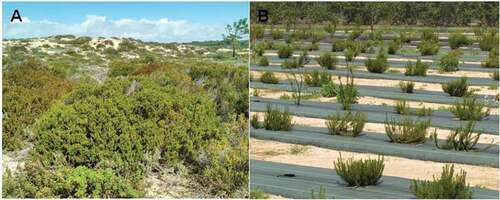
Pictures of phenological stages were taken in situ. Samples, related to male and female reproductive development, were collected for a detailed image. Samples were collected in falcon tubes, transported to laboratory and observed in the same day or the following day after collection. This was achieved by using stereomicroscope Leica DM1000 (Leica, Singapore) and the 3D acquisition software 126 “Leica Application Suite V4.04.” Images taken by using stereomicroscope have a scale attached.
Scale System Methodology
Phenological observations were organized in principal, secondary and mesostages. According to the BBCH scale, 10 principal growth stages are recognizable, numbered from 0 to 9, where 0 stands for germination/sprouting/bud development all the way to 9 which is senescence/beginning dormancy. Shorter growth stages occurring within a principal growth stage were described as secondary developmental stages, where a third digit was used, providing a three digit description for plant development, which could also be between 0 and 9.
Seven of the 10 principal growth stages were used to describe C. album phenology. The phenological stages used were vegetative bud development (Stage 0), leaf development (Stage 1), main stem elongation (Stage 3), inflorescence emergence (Stage 5), flowering (Stage 6), fruit development (Stage 7) and fruit maturation (Stage 8).
Corema album is an evergreen woody plant, so three principal stages were not applied to the species: stage 2 (formation of side shoots), stage 4 (development of harvestable vegetative parts) and stage 9 (senescence). In other dioecious plants (e.g. kiwifruits (Salinero et al., Citation2009), willow (Saska and Kuzovkina, Citation2010) and asparagus (Feller et al., Citation2012)), stages 5 (inflorescence emergence) and 6 (flowering) were mainly focused on female plants. In this work, descriptions and pictures for both male and female stages were taken into account.
Results
Stage 0: Bud development
The first vegetative buds were occurred in the spring from February to March ()
Figure 2. White crowberry’s (Corema album) vegetative development stages (stages 0, 1 and 3) according to the BBCH scale.
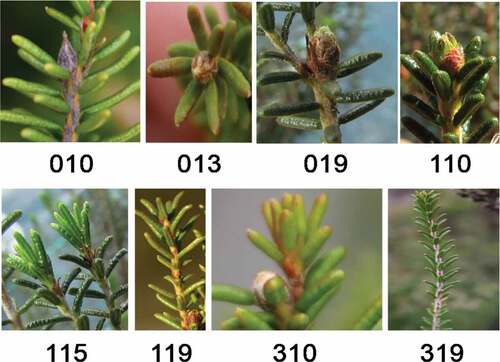
010 Dormancy
Bud has a dark grayish color, with a conic shape.
011Beginning of bud swelling
Beginning of leaf bud swelling: bud scales have a black coloration, and when separated, the bud core has a beige or yellowish color.
013 End of leaf bud swelling
Bud has a brown coloration, with a white/beige color in the bud scale interstices.
017 Beginning of bud break
Light green leaf tips start to be visible, although covered with hairs
019 Bud break
Small primordial leaf tips are visible (less than 1 mm)
Additional flush: an additional vegetative flush is observed in autumn from September to October. ()
020 Dormancy
021Beginning of bud swelling
023 End of leaf bud swelling
027 Beginning of bud break
029 Bud break
Stage 1: Leaf development
Leaves start to develop in the spring, and are developed from March to August ()
110 First visible leaf tips
Light green leaves are still welded to each other in the extremities, as well as in the middle of the bud.
115 Half of the leaves are unfolded
119 All leaves are unfolded
Additional flush: an additional vegetative flush is observed in Winter from October to January. ()
120 First visible leaf tips
125 Half of the leaves are unfolded
129 All leaves are unfolded
Stage 3: Main stem elongation
The main stem develops during Spring (March) to Summer (August) ().
310 Beginning of stem growth
Stem has a red/yellowish color.
315 Stem with half of the final length
Stem has a brown/yellowish color.
319 Full formed stem
Stem has a brown/grayish color.
Additional flush: an additional vegetative flush is observed in Winter from October to January. ()
320 Beginning of stem growth
325 Stem with half of the final length
329 Full formed stem
Stage 5: Inflorescence emergence (Winter/Spring)
510 Floral buds are closed and covered with white hairs.
In male plants (. 510A), floral buds are similar to vegetative buds, however, bigger and with a rounder shape. This bud has a yellowish color, covered with white hairs. Meanwhile, in female plants (. 510B), flower buds have a higher resemblance to the vegetative bud than the male, due to the similar conical shape, although a little rounder.
Figure 3. White crowberry’s (Corema album) male flower development stages (stages 5 and 6) according to the BBCH scale.

Figure 4. White crowberry’s (Corema album) female flower development stages (stages 5 and 6) according to the BBCH scale.
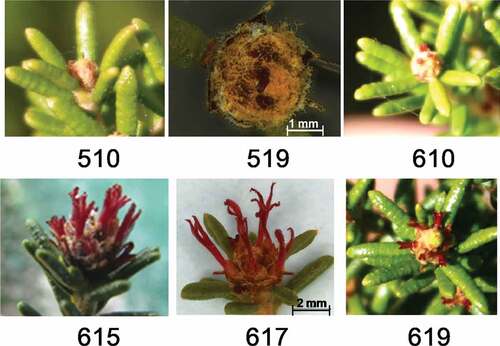
515 Floral buds continue to grow.
In male plants, flowers are covered with scales start to individualized. Rounder protrusions with a yellowish color start to appear from beneath of the white hairs, which are starting to disappear. In female plants, the floral bud is protected with white hairs.
519 Male flowers (. 519A) are clearly visible and individualized with dark brown scales. Visible brown spheres are well individualized in the bud. In female flowers (. 519B), floral buds are still covered with white hairs, but individual stigmata start to emerge from the center of the bud.
Stage 6: Flowering (Winter/Spring)
610 In male flowers (. 610A), scales start to open and the first red colored anthers emerge. In female flowers (. 610B), stigmata begins to emerge. Flower buds are covered with hairs. Red stigmata start to appear from beneath the hairs.
611 Beginning of flowering
Scales protecting male flowers continue to open and at least 10% of the anthers are visible. The red color starts to vanish, and takes place a pink coloration. In female flowers, stigmata emerge in sets of three per ovary, with an intense red color.
615 Full flowering
Anthers start to release pollen (. 615A). The filament is still elongating and has a pale white color. The stigmata from female flowers (. 615B) are distributed along the bud and are still elongating. The central zone of the bud starts to lack the presence of stigmata.
617 Pollination Takes Place
In the beginning of anthers dehiscence (. 617A), filaments are white coloured. Pollen release is in full stage. In female plants (. 617B), stigmata are full elongated and receptive to pollen. The final size of stigmata is achieved, with a slender shape and a bifurcation on the apex with a dark red coloration. In the centre, the vegetative growth starts to appear.
619 End of Flowering
Anthers turn dark brown and filaments turn dark yellow (. 619A), senescence takes place and male flowers start falling. In female flowers (. 619B), in the basal area of the stigmata, the ovary starts to swell leading to fruit setting.
Stage 7: Fruit Development (Spring/Summer) ()
Figure 5. White crowberry’s (Corema album) fruit development stages (stages 7 and 8) according to the BBCH scale.
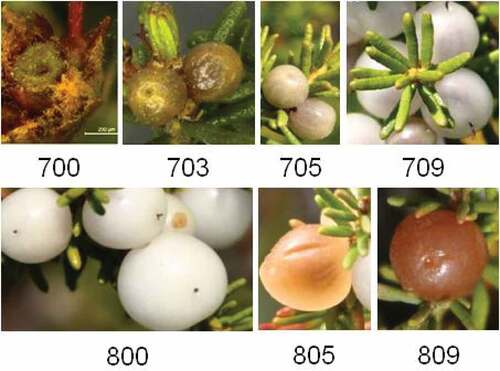
Figure 6. White crowberry’s sequential progression of phenological growth stages (horizontal bars). Historical data set from 1971 to 2000 was used to represent meteorological data from Setubal district, where Praia do Meco is located. Maximum and minimum temperatures (°C) are represented with lines and bars (vertical bars) represent precipitation (mm).
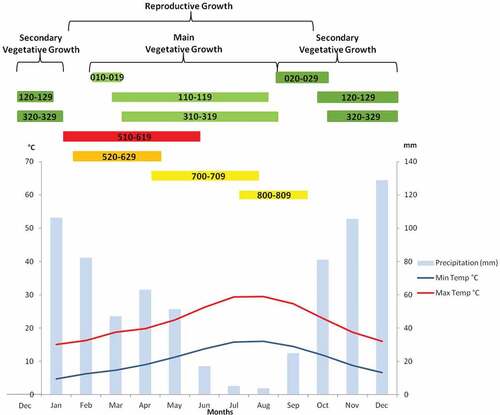
700 Fruit setting
Fruit formation starts due to the swelling of the ovary, turning spherical with a depression near the stigmata insertion and presenting a light green color.
701Fruits with 10% of final size
Fruits increase in volume and the central depression disappears. Coloration starts to turn more opaque and greenish white.
703 Fruits with 30% of final size
Fruit size continues to increase, although is more accentuated in the longitudinal axis, which gives a more elongated shape to fruits. Color start to change from a grayish white to a whiter shade.
705 Fruits with 50% of final size
706 Fruits with 60% of final size
White fruits continue to increase in size, growth starts in transversal axis, turning into a spherical fruit.
709 Fruits with 90% of full sized or fully formed
Fruits achieve their final size and have a white color, turning into a spherical shape slightly flattened in the longitudinal axis.
Stage 8: Fruit maturation (Summer) ()
800 Fruit maturation
Physiological maturation of the fruit, with a white coloration.
803 Fruits start to turn translucent
805 Advanced maturation
Fruits start to develop some yellow and brown areas in the epidermis.
807 Beginning of fruit senescence
Fruits start to softened and to develop some grooves.
809 Fruit senescence
Fruits present a full dark brown coloration.
Discussion
Corema album is a wild species; however, efforts are being made to include it in the berry market, in a near future. The establishment of phenological stages is very important to understand the plant response to several horticultural operations like irrigation, fertilization, training and pruning.
Magalhães (Citation2015) and Magalhães et al. (Citation2017), as said previously, did a first approach to a BBCH-scale for the white crowberry; however, the work did not follow all plant’s annual cycle, specially between late fall and early winter, and was based only in a single year observation. Whereas in this study, the phenological development was recorded for 4 years in wild and 5 years in experimental fields (along the year of 2015 and 2018 for wild plants in Praia do Meco and from 2015 to 2019 in field conditions) and main growth stages are represented in .
Two different forms of vegetative growths were observed: in the first, a single terminal bud develops, leading to a single shoot (less common) and in the other form, axillary buds develop alongside the terminal bud, developing between two and six shoots (usually three), but in this situation, the terminal shoot stops developing (more common). A major vegetative growth outbreak was registered during Spring/Summer period, although a second vegetative period was observed during fall.
Differences between both sexes, regarding the number of vegetative growths, were not found. Although in a study by Zunzunegui et al. (Citation2006) differences were found, where female plants had lower number of vegetative growths compared to male plants, which could be related to the trade-off between reproductive/vegetative organs as observed in Álvarez-Cansino et al. (Citation2012). Our observations were according to Martins et al. (Citation2017), which found weak evidences of this mechanism.
Hermaphroditic plants were not found in this sampling site, like it was described in Asperillo and Vila Real de Santo António by Zunzunegui et al. (Citation2006), probably due to sites higher rates of aridity, when compared to Praia do Meco.
Concerning fruit setting and development, Corema album develops fruits during the period of higher temperatures and almost inexistent precipitation (Zunzunegui et al., Citation2006) (), that is, from April to August. Fruit setting starts with ovary intumescence, which has a green-yellowish color, with a depression in the base of the stigmata. This concavity starts to get filled up, with the fruit development that as now a translucent green color. Usually, three fruits develop properly within each inflorescence.
Fruit maturation is strongly influenced by weather/climatic conditions. Jacinto (Citation2019) compared four populations in the Portuguese coast and observed that, along a latitudinal gradient, plants further south had ripe fruits earlier (beginning of August) when compared to plants in the north (late September). Newly formed fruits have a similar shape to fully formed ones, although more elongated and with a greenish color. During fruit formation, the green color turns white and transparencies start to disappear. However, some fruits never lose the transparency. In terms of shape the elongated sphere, develops into a rounded sphere and full developed fruits have a flattened sphere form. Some variability was found regarding fruit shape and color, which was also described in other works (Guitián et al., Citation1997; Larrinaga, Citation2010; Larrinaga and Guitián, Citation2016). When fruit volume starts to increase, female plants have a decrease regarding vegetative growth, compared to male plants, as described by Álvarez-Cansino et al. (Citation2010) and Zunzunegui et al. (Citation2006).
Completely mature fruits are white, after that, small translucent brown spots start to form in some parts of the fruit. After a while, the spots increase in size and cover the entire fruit that turns completely brown and soft.
Conclusions
The observations made in the sand dunes of Praia do Meco, during 2015 and 2018, were further validated in C. album plants from a clonal field at Small Fruits Experimental Farm. This validation strongly supports our scale proposal, once the accuracy of phenological development was observed in the six genotypes of the 10 geographical origins.
The development of an extended BBCH scale for Corema album’s phenological stages will have an application in the fields of agronomy, plant breeding, physiology or even pathology and entomology. Throughout this scale, we will promote more effective planning and management of scientific experiments. It will allow a precise timing for agronomical practices, specially related to training and pruning, where further studies must be conducted to understand the best timing for these operations. The BBCH-scale will also be crucial for planning artificial pollinations, if a future breeding program will be in order.
Acknowledgments
The study was funded by the project “GO Competitive SouthBerries” (partnership 21/initiative 29/PDR2020-101-031721) co-financed by PDR2020, Portugal 2020 and the European Commission.
Disclosure Statement
No potential conflict of interest was reported by the author(s).
Additional information
Funding
References
- Adiga, J.D., B.M. Muralidhara, P. Preethi, and S. Savadi. 2019. Phenological growth stages of the cashew tree (Anacardium occidentale L.) according to the extended BBCH scale. Annals of Applied Biology. 175(2):246–252. doi: 10.1111/aab.12526.
- Agustí, M., S. Zaragoza, H. Bleiholder, L. Buhr, H. Hack, R. Klose, and R. Staub. 1997. Adaptation de l’échelle BBCH à la description des stades phénologiques des agrumes du genre Citrus. Fruits. 52(5):287–295. https://revues.cirad.fr/index.php/fruits/article/view/35585.
- Álvarez-Cansino, L., M.C. Díaz-Barradas, M. Zunzunegui, M.P. Esquivias, and T.E. Dawson. 2012. Gender-specific variation in physiology in the dioecious shrub Corema album throughout its distributional range. Functional Plant Biology. 39(12):968–978. doi: 10.1071/FP12131.
- Álvarez-Cansino, L., M. Zunzunegui, M.C. Díaz-Barradas, and M.P. Esquivias. 2010. Gender-specific costs of reproduction on vegetative growth and physiological performance in the dioecious shrub Corema album. Ann. Bot. 106(6):989–998. doi: 10.1093/aob/mcq197.
- Andrade, S.C., F. Gonçalves, and R. Guiné. 2017a. Contribution for the physical-chemical characterization of Portuguese Crowberry (Corema album). International Journal of Food Science and Nutrition. 2(4):9–14.
- Andrade, S.C., R.P. Guiné, and F.J. Gonçalves. 2017b. Evaluation of phenolic compounds, antioxidant activity and bioaccessibility in white crowberry (Corema album). Journal of Food Measurement and Characterization. 11(4):1936–1946. doi: 10.1007/s11694-017-9576-4.
- Awachare, C.M., and K.K. Upreti. 2020. Phenological growth stages in mangosteen (Garcinia mangostana L.) according to the extended BBCH scale. Annals of Applied Biology. 176(1):16–25. doi: 10.1111/aab.12552.
- Díaz-Barradas, M.C., M. Zunzunegui, O. Correia, F. Ain-Lhout, M.P. Esquivias, and L. Álvarez-Cansino. 2018. Gender dimorphism in Corema album across its biogeographical area and implications under a scenario of extreme drought events. Environ. Exp. Bot. 155:609–618. doi: 10.1016/j.envexpbot.2018.08.011.
- Feller, C., E. Richter, T. Smolders, and A. Wichura. 2012. Phenological growth stages of edible asparagus (Asparagus officinalis): Codification and description according to the BBCH scale. Annals of Applied Biology. 160(2):174–180. doi: 10.1111/j.1744-7348.2012.00530.x.
- Font-Quer, P. 1993. Plantas medicinales: El Dioscórides renovado. Labor, Barcelona.
- Franco, J.A. 1984. Nova flora de Portugal: (continente e Açores). Vol.2. Clethraceae - Compositae. Soc. Astória, Lisboa, Portugal.
- Gil-López, M.J. 2011. Etnobotánica de la camarina (Corema album, Empetraceae) en Cádiz. Acta Bot Malacitana. 36:137–144. doi: 10.24310/abm.v36i1.2784.
- González, G. 2006. Los árboles y arbustos de la Península Ibérica e Islas Baleares. Mundi-Prensa, Madrid.
- Guan, C., Q. Che, P. Zhang, J. Huang, S. Chachar, X. Ruan, Y. Yang, and Y. Yang. 2021. Codification and description of growth stages in persimmon (Diospyros kaki Thunb.) using the extended BBCH scale. Sci. Hortic. 280:109895. doi: 10.1016/j.scienta.2021.109895.
- Guitián, P., M. Medrano, and M. Rodríguez. 1997. Reproductive biology of Corema album (L.) D. Don (Empetraceae) in the northwest Iberian Peninsula. Acta Botanica Gallica. 144(1):119–128. doi: 10.1080/12538078.1997.10515759.
- Hack, H., H. Bleiholder, L. Buhr, U. Meier, U. Schnock-Fricke, E. Weber, and A. Witzenberger. 1992. Einheitliche codierung der phänologischen entwicklungsstadien mono-und dikotyler pflanzen–erweiterte BBCH-Skala, Allgemein. Nachrichtenblatt des deutschen Pflanzenschutzdienstes. 44(12):265–270.
- Hack, H., H. Gall, T.H. Klemke, R. Klose, U. Meier, R. Stauss, and A. Witzenberger 1993. The BBCH scale for phenological growth stages of potato (Solanum tuberosum L.). In Proceedings of the 12th Annual Congress of the European Association for Potato Research, Quedlinburg, Germany: Federal Biological Research Centre for Agriculture and Forestry. (pp. 153–154).
- Hellmann, C., R. Sutter, K.G. Rascher, C. Máguas, O. Correia, and C. Werner. 2011. Impact of an exotic N2-fixing Acacia on composition and N status of a native Mediterranean community. Acta Oecologica. 37(1):43–50. doi: 10.1016/j.actao.2010.11.005.
- IPMA: Period of 1971-2000, Setubal district. (Accessed: February 2018). http://www.ipma.pt/pt/oclima/normais.clima/1971-2000/#170
- Jacinto, J. (2019). Morphological and genetic characterization of four populations of Corema album (L.) Don (Master's dissertion). , ISA/UL.
- Lancashire, P.D., H. Bleiholder, T.V.D. Boom, P. Langelüddeke, R. Stauss, E. Weber, and A. Witzenberger. 1991. A uniform decimal code for growth stages of crops and weeds. Annals of Applied Biology. 119(3):561–601. doi: 10.1111/j.1744-7348.1991.tb04895.x.
- Larrinaga, A.R. 2010. Rabbits (Oryctolagus cuniculus) select small seeds when feeding on the fruits of Corema album. Ecological Research. 25(1):245–249. doi: 10.1007/s11284-009-0635-0.
- Larrinaga, A.R., and P. Guitián. 2016. Intraspecific variation in fruit size and shape in Corema album (Ericaceae) along a latitudinal gradient: From fruits to populations. Biological Journal of the Linnean Society. 118(4):940–950. doi: 10.1111/bij.12794.
- León-González, A.J., P. Truchado, F.A. Tomás-Barberán, M. López-Lázaro, M.C. Díaz-Barradas, and C. Martín-Cordero. 2013. Phenolic acids, flavonols and anthocyanins in Corema album (L.) D. Don berries. Journal of Food Composition and Analysis. 29(1):58–63. doi: 10.1016/j.jfca.2012.10.003.
- Lopéz-Dóriga, I. 2018. The Archaeobotany and Ethnobotany of Portuguese or White Crowberry (Corema album). Ethnobiology Letters. 9(2):19–32. doi: 10.14237/ebl.9.2.2018.1069.
- Lorenz, D.H., K.W. Eichhorn, H. Bleiholder, R. Klose, U. Meier, and E. Weber. 1994. Phänologische Entwicklungsstadien der Weinrebe (Vitis vinifera L. ssp. vinifera). Codierung und Beschreibung nach der erweiterten BBCH-Skala. Wein-Wissenschaft. 49(2):66–70.
- Magalhães, T. 2015. Propagação e fenologia da Corema album (L.) D. Don. Ensaios de propagação vegetativa por estaca. Caracterização fenológica e proposta de escala BBCH. Master’s Dissertation. ISA.UL
- Magalhães, T., P.B. Oliveira, and C. Oliveira. 2017. Propagação e fenologia da Corema album. D. (L.) Don Novas Edições Acadêmicas.
- Marques, E.M.M.S. 2007. Caracterização das populações de Camarinha (Corema album L.) no Cabo Carvoeiro, Master’s Dissertation, FC. UL.
- Martins, A., H. Freitas, S. Costa, and J.T.M. Elzenga. 2017. Corema album: Unbiased dioecy in a competitive environment. Plant Biology. 19(5):824–834. doi: 10.1111/plb.12584.
- Meier, U. 1997. Growth stages of mono-and dicotyledonous plants. : BBCH Monograph Blackwell Wissenschafts-Verlag.
- Meier, U., H. Graf, H. Hack, M. Hess, W. Kennel, R. Klose, and T.V.D. Boom. 1994. Phanologische Entwicklungsstadien des Kernobstes (Malus domestica Borkh. und Pyrus communis L.), des Steinobstes (Prunus-Arten), der Johannisbeere Ribes-Arten) und der Erdbeere (Fragaria x ananassa. Nachrichtenblatt des Deutschen Pflanzenschutzdienstes. 46(7):141–153.
- Oliveira, P.B., and A. Dale. 2012. Corema album (L.) D. Don, the white crowberry–a new crop. Journal of Berry Research. 2(3):123–133. doi: 10.3233/JBR-2012-033.
- Ramírez, F., and T.L. Davenport. 2020. The development of Lulo Plants (Solanum quitoense Lam. var. Septentrionale) characterized by BBCH and landmark phenological scales. International Journal of Fruit Science. 20(3):562–585. doi: 10.1080/15538362.2019.1613470.
- Ramírez, F., G. Fischer, T.L. Davenport, J.C.A. Pinzón, and C. Ulrichs. 2013. Cape gooseberry (Physalis peruviana L.) phenology according to the BBCH phenological scale. Sci. Hortic. 162:39–42. doi: 10.1016/j.scienta.2013.07.033.
- Ramírez, F., and J. Kallarackal.2018.Phenological growth stages of Feijoa [Acca sellowiana (O. Berg) Burret] according to the BBCH scale under tropical Andean conditions.Sci. Hortic. 232(December):184–190.DOI: 10.1016/j.scienta.2017.12.059. 2017
- Salinero, M.C., P. Vela, and M.J. Sainz. 2009. Phenological growth stages of kiwifruit (Actinidia deliciosa ‘Hayward’). Sci. Hortic. 121(1):27–31. doi: 10.1016/j.scienta.2009.01.013.
- Sanz‐Cortés, F., J. Martínez‐Calvo, M.L. Badenes, H. Bleiholder, H. Hack, G. Llacer, and U. Meier. 2002. Phenological growth stages of olive trees (Olea europaea). Annals of Applied Biology. 140(2):151–157. doi: 10.1111/j.1744-7348.2002.tb00167.x.
- Saska, M.M., and Y.A. Kuzovkina. 2010. Phenological stages of willow (Salix). Annals of Applied Biology. 156(3):431–437. doi: 10.1111/j.1744-7348.2010.00400.x.
- Simmonds, N.W. 1979. Principles of crop improvement. Longman Principles of crop improvement . 408.
- Tutin, T.G., V.H. Heywood, N.A. Burges, D.M. Moore, D.H. Valentine, S.M. Walters, and D.A. Webb. 1972. Flora Europea. Diasporaceae to Myoporaceae. Vol. 3. Cambridge University Press, Cambridge, England. p. 70.
- Ventura, F., M. Vignudelli, G.M. Poggi, L. Negri, and G. Dinelli. 2020. Phenological stages of Proso millet (Panicum miliaceum L.) encoded in BBCH scale. Int J Biometeorol. 1–15. doi: 10.1007/s00484-020-01891-3.
- Zunzunegui, M., M.D. Díaz-Barradas, A. Clavijo, L. Álvarez-Cansino, F.A. Lhout, and F.G. Novo. 2006. Ecophysiology, growth timing and reproductive effort of three sexual forms of Corema album (Empetraceae). Plant Ecology. 183(1):35–46. doi: 10.1007/s11258-005-9004-4.
